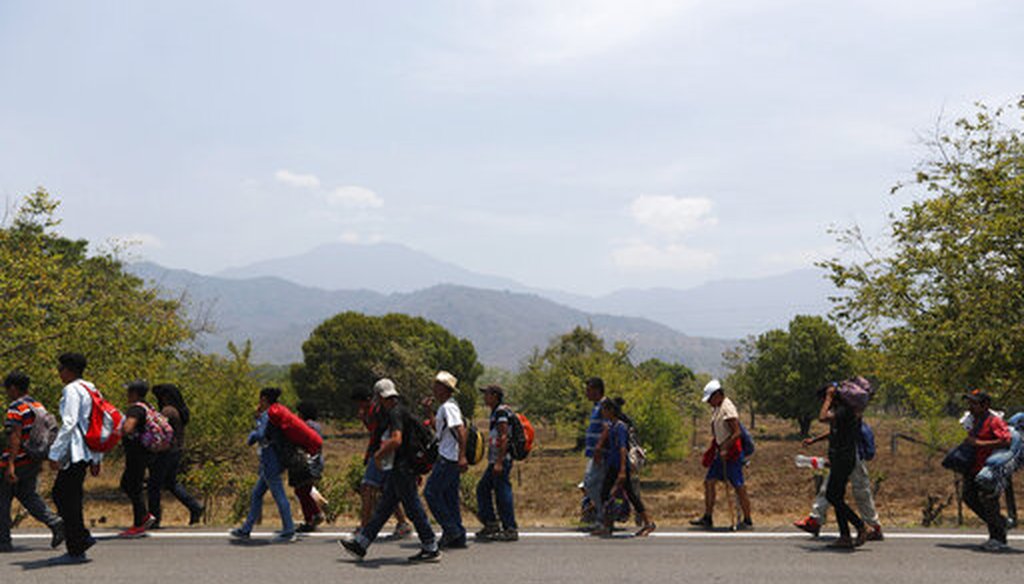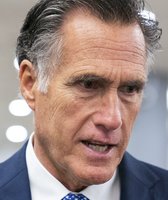Get PolitiFact in your inbox.

Central American migrants traveling in a caravan to the U.S. walk through Tonala, Chiapas state, Mexico, April 21, 2019. (AP/Moises Castillo)
Less than three months ago, President Donald Trump was unequivocal in his assessment of Mexico’s efforts to stop illegal immigration to the United States: "Mexico is doing NOTHING to help stop the flow of illegal immigrants to our Country," he tweeted March 28.
Now, he claims that Mexico is a greater help than America’s own elected leaders: "Now with our new deal, Mexico is doing more for the USA on Illegal Immigration than the Democrats," Trump tweeted June 10.
Trump’s tune changed after a June 7 agreement between the United States and Mexico that seeks to curb the number of people seeking asylum at the southern U.S. border. The impact of that agreement — which Trump claims contains a yet-to-be-revealed provision — remains to be seen. Mexico, meanwhile, says all the details are already in the open, denying Trump’s statements that there are additional, unreleased parts to the agreement.
Given all the discussion and dispute, we wanted to take a step back and revisit what we know about Mexico’s recent history regarding migrants seeking new homes in the United States.
What measures has Mexico taken in the past to try to limit the number of people who illegally cross the United States’ southern border? And what do we actually know about the new deal with Trump?
Here’s an overview:
Mexico’s immigration enforcement data says that from January to April 2019, Mexico sent around 37,000 Central Americans back to their countries, mostly to El Salvador, Honduras, and Guatemala.
In 2018, Mexican authorities returned close to 110,000 Central Americans to their countries. That number was 78,300 in 2017; 151,000 in 2016; and 177,000 in 2015. (See data for additional years here.)
Over the years, the majority of Central Americans returned by Mexican officials reported that they had been intending to reach the United States when they were detained by authorities, according to 2009 to 2017 surveys by the Mexico-based El Colegio de la Frontera Norte.
In 2014, the United States had a surge of Central American children arriving alone to the U.S. southwest border seeking asylum. Many left their countries fleeing gang violence and poverty.
The Obama administration in 2014 sought help from Mexico and Central America to deter immigration, improve Mexico’s and Guatemala’s ability to interdict migrants, enhance Central America’s ability to receive and reintegrate deported migrants, and to address the underlying causes of migration.
Mexico in 2014 launched the Programa Frontera Sur (South Border Program) to protect migrants and manage its own ports of entry. Mexico has since established 12 naval bases on its rivers, a drone surveillance program, and three security cordons stretching more than 100 miles north of the Mexico-Guatemala and Mexico-Belize borders, the U.S. Congressional Research Service reported in a January 2019 summary of Mexico’s immigration control efforts.
Since Mexico does not have a border police force, the summary said, Mexico’s National Institute of Migration is the sole agency with legal authority to detain migrants, with some assistance from the federal police. "These unarmed agents have worked to increase immigration control along known migrant routes, including on northbound trains and at bus stations," the Congressional Research Service said.
Still, increased checkpoints in Mexico and raids on northbound trains cause migrants to take more dangerous routes and to rely on smugglers, the research agency said. Migrants have also sought safety in numbers by joining caravans for the trek.
Trump threatened to impose tariffs on Mexico unless Mexico ramped up its efforts to stop the flow of people reaching the United States seeking asylum. Trump then backed down, tweeting on June 7 that Mexico "agreed to take strong measures to stem the tide of migration through Mexico, and to our southern border."
The details of that agreement have been the subject of dispute by parties in the United States and Mexico. Trump claimed that Mexico agreed to "immediately" start buying more products from American farmers. Mexico said it didn’t. Trump also tweeted that the nations agreed on other things that haven’t been publicly released yet. But Mexican Foreign Minister Marcelo Ebrard said all that was agreed on was already publicly disclosed.
In a June 10 press conference, Ebrard said that after "very intense negotiations," the two countries agreed on two measures: One, that the Mexican national guard would be deployed across the country, prioritizing Mexico’s southern border, to stem the flow of migration to the United States. That’s something that had previously been established, he said.
Two, Mexico will continue accepting migrants who have applied for asylum in the United States and are waiting for a resolution of their case. Ebrard said Mexico agreed to this because it respects the right to asylum.
Mexico’s new president, Andrés Manuel López Obrador, inaugurated December 2018, has echoed what other Mexican presidents have said: That the root problems causing Central Americans’ to migrate — violence and poverty — must be addressed, said Rafael Fernández de Castro, a professor at the University of California-San Diego and a former foreign policy adviser to former Mexican President Felipe Calderón.
"Over the years, besides accommodating U.S. interests, Mexico has aimed to have an orderly and safe migrant flow, but it’s been difficult to do this," said Fernández de Castro.
It’s possible that the U.S.-Mexico agreement will lead to a short-term drop in the number of people arriving at the U.S. southern border, but that decrease might not last if the underlying issues are not handled, he said.
The United States and Mexico set an initial 45-day deadline to evaluate the effectiveness of their agreement and to negotiate other steps if those measures don’t work.
Our Sources
Phone interview, Rafael Fernández de Castro, a professor at the University of California-San Diego and a former foreign policy adviser to former Mexican President Felipe Calderón, June 12, 2019
State Department, U.S.-Mexico Joint Declaration, June 7, 2019
Twitter, @gobiernoMX tweet, June 10, 2019
Twitter, @realdonaldtrump tweet, March 28, 2019; tweet, June 7, 2019; tweet, June 9, 2019 tweet, June 10, 2019
El Universal, No hay acuerdo secreto, responde Ebrard a Trump, June 12, 2019
Mexican government, 2019 immigration enforcement data, January - April, historical data
El Colegio de la Frontera Norte, Data Tables of the Survey of Migration at Mexico’s Southern Border, last updated May 2019
Obama White House, The Obama Administration’s Government-Wide Response to Influx of Central American Migrants at the Southwest Border, Aug. 1, 2014
Wilson Center, Mexico’s Southern Border Strategy: Programa Frontera Sur, July 11, 2014
Congressional Research Service, Mexico’s Immigration Control Efforts, Jan. 3, 2019
PolitiFact, Donald Trump says Mexico agreed to start buying more from American farmers. Mexico says it didn’t., June 10, 2019
GAO.gov, Central America — Improved Evaluation Efforts Could Enhance Agency Programs to ReduceUnaccompanied Child Migration, July 2015


































